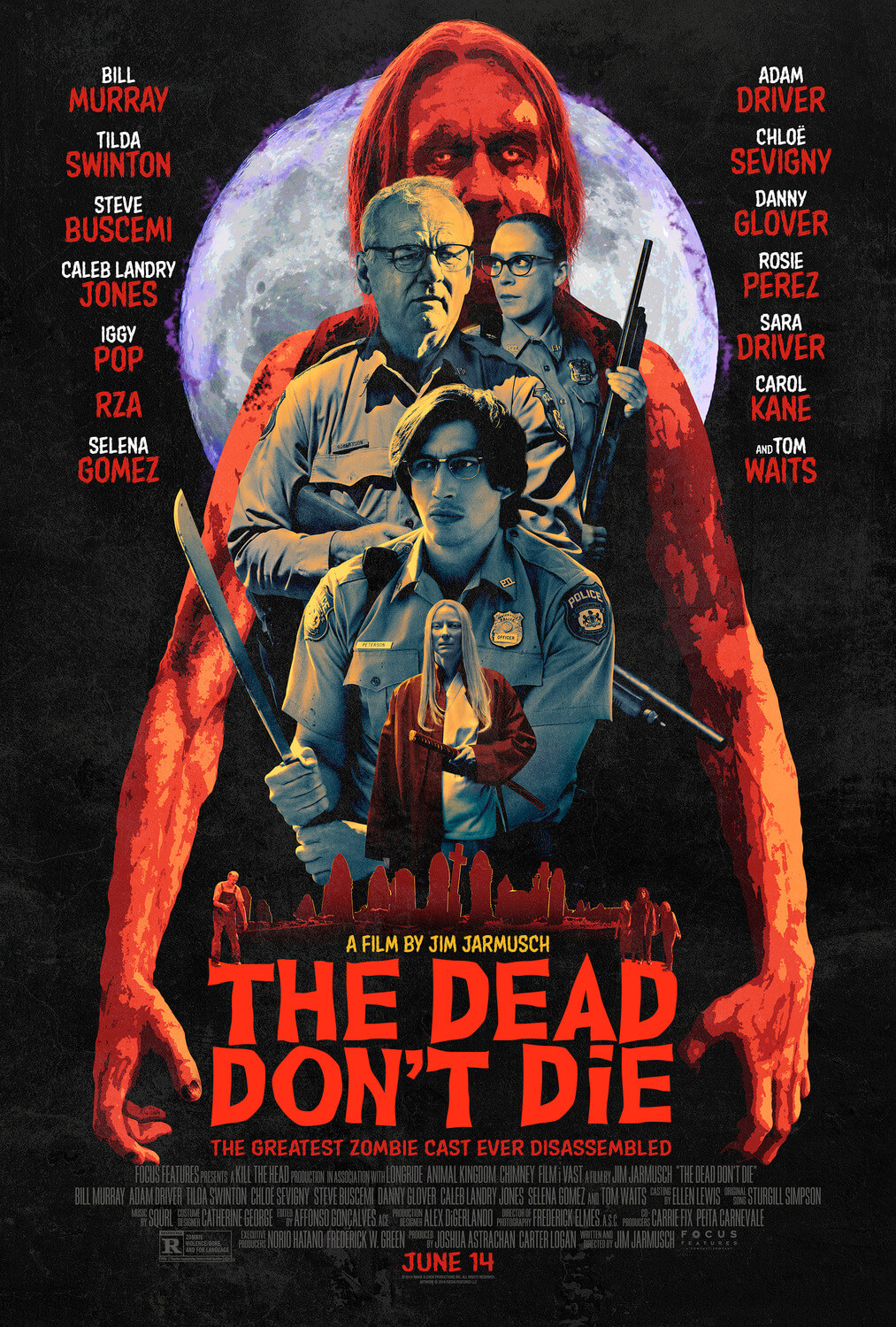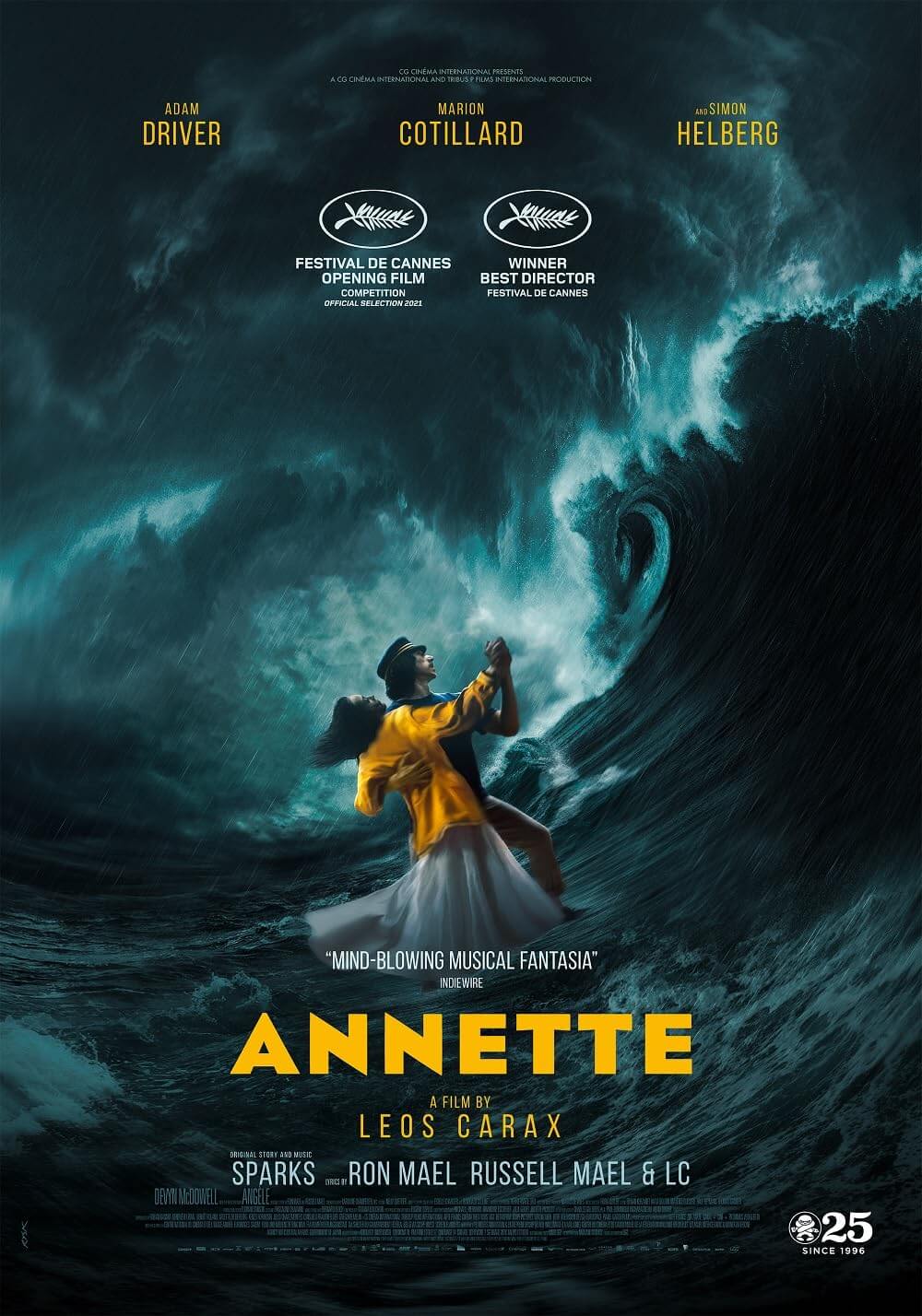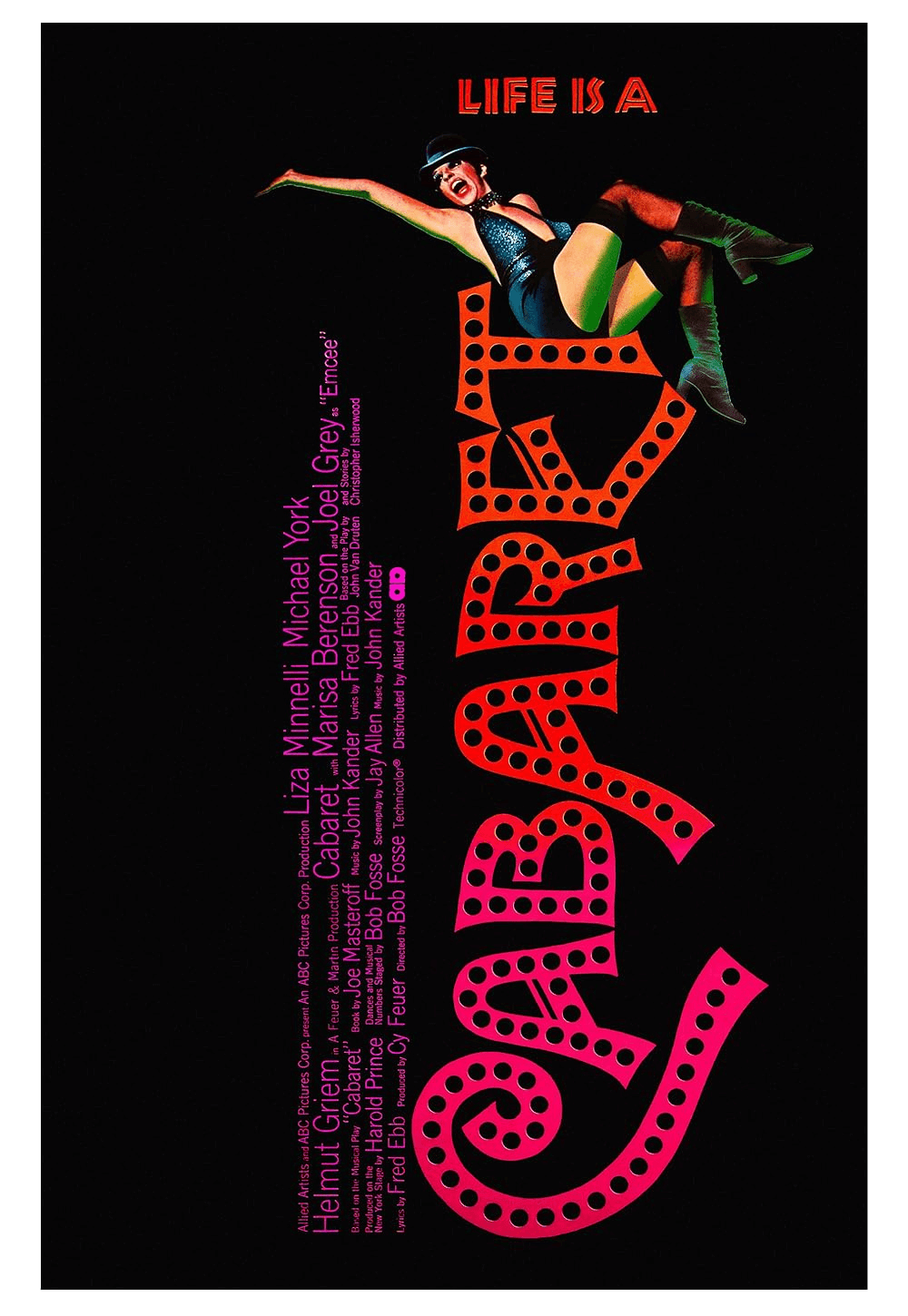The Definitives
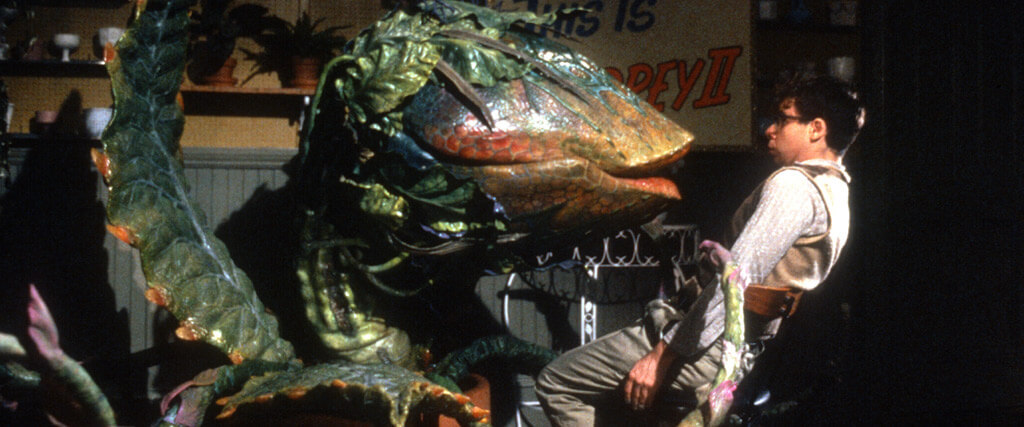
Little Shop of Horrors
Essay by Brian Eggert |
Little Shop of Horrors has all the makings of an essential cult film. Released in 1986, during a decade steeped in nostalgia for the early days of rock-and-roll and Motown, the film combines those musical styles with a Broadway scope. From its soundtrack to narrative structure, the film merges well-known genres in unexpected ways. It’s a collision of the classical Hollywood musical and creature feature, it boasts dark themes and brilliant puppet work, and it tickles the audience with subversive lyrics and disturbing turns of plot. Even so, director Frank Oz, himself associated with Muppets and Jim Henson, has shot every musical number so that each draws us closer to the characters played by stars Rick Moranis and Ellen Greene, making the film an unlikely but genuinely touching love story. It could also be viewed as pure comedy, as names like Steve Martin, Bill Murray, and John Candy steal their scenes in enduringly funny performances. At the time of its release, Little Shop of Horrors was only moderately successful, but audiences keep revisiting its many pleasures—and occasionally, to weigh its complex relationship with film and music history, racial representation, and its alternate ending. Sure enough, it’s the sort of film that works on the surface and beneath it, inviting both closer examination and zealous cult viewership.
It debuted during the cable television and VHS cassette boom of the mid-1980s, when over 70 percent of homes in the U.S. had video recorders and upwards of 50 million families subscribed to basic cable. Many cult films from this era developed out of narrow viewing options, before the age of on-demand. Choices were limited by what your family had in its tape collection, could rent at the video store, or had recorded from television broadcasts. Cable networks like HBO acquired and programmed films for their stations, showing them on a regular rotation. Films that bombed in theaters could be purchased cheaply by cable channels, which aired again and again. More successful films had a higher price tag, and networks paid a hefty sum to host the cable TV debut of the latest blockbuster. The sheer omnipresence of films such as Ghostbusters (1982), the teen comedies of John Hughes, anything with Steven Spielberg’s name attached, John Carpenter’s The Thing (1982), and Brian De Palma’s Scarface (1983) on television and videocassette ingrained these titles into a generation of movie fans who watched them on repeat. Similarly, Little Shop of Horrors performed moderately well at the box office, earning nearly $40 million on a budget of $25 million, but the cult around this musical formed in the secondary market of at-home viewing.
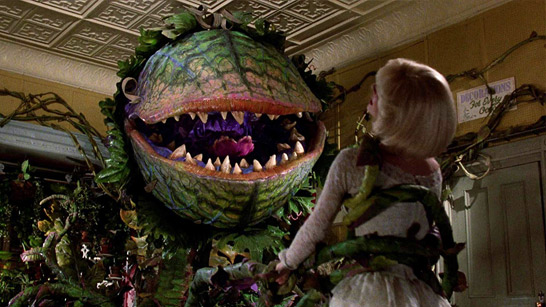 The film’s origin goes back to Roger Corman’s shoestring-budgeted 1960 original, The Little Shop of Horrors, with notable appearances by Dick Miller, Jackie Joseph, and a young Jack Nicholson. Screenwriter Charles B. Griffith based his story on the 1932 book by John Collier, Green Thoughts, though Arthur C. Clarke’s 1956 short story “The Reluctant Orchid” may have also influenced him as well. Corman’s version—which completed filming in under a week by making use of sets left standing from his previous picture, the pitch-black comedy A Bucket of Blood (1959)—is a Frankenstein-esque tale. It follows amateur botanist Seymour Krelborn (Jonathan Haze) who, like a mad scientist, crosses a “butterwort and a Venus flytrap” to create a flesh-eating monster, though later he mentions finding seeds of unknown origin. Griffith voices the killer plant, here named Audrey Jr., with a voice that echoes the film’s decidedly Jewish tenor. In addition to the nebbish Seymour, most of Griffith’s characters are Jewish stereotypes: there’s the penny-pinching flower shop owner Mr. Mushnik, or others who have names like “Shivah” (after the Jewish time of mourning) or “Feuchtwanger” (after the German-Jewish author). Although a major difference in the original is that the plant has no stated plans for world domination, Seymour falls prey to its irrepressible hunger in the end.
The film’s origin goes back to Roger Corman’s shoestring-budgeted 1960 original, The Little Shop of Horrors, with notable appearances by Dick Miller, Jackie Joseph, and a young Jack Nicholson. Screenwriter Charles B. Griffith based his story on the 1932 book by John Collier, Green Thoughts, though Arthur C. Clarke’s 1956 short story “The Reluctant Orchid” may have also influenced him as well. Corman’s version—which completed filming in under a week by making use of sets left standing from his previous picture, the pitch-black comedy A Bucket of Blood (1959)—is a Frankenstein-esque tale. It follows amateur botanist Seymour Krelborn (Jonathan Haze) who, like a mad scientist, crosses a “butterwort and a Venus flytrap” to create a flesh-eating monster, though later he mentions finding seeds of unknown origin. Griffith voices the killer plant, here named Audrey Jr., with a voice that echoes the film’s decidedly Jewish tenor. In addition to the nebbish Seymour, most of Griffith’s characters are Jewish stereotypes: there’s the penny-pinching flower shop owner Mr. Mushnik, or others who have names like “Shivah” (after the Jewish time of mourning) or “Feuchtwanger” (after the German-Jewish author). Although a major difference in the original is that the plant has no stated plans for world domination, Seymour falls prey to its irrepressible hunger in the end.
Corman’s film had become such an underground hit with teen and midnight madness audiences that Alan Menken and Howard Ashman resolved to adapt the material into an Off-Broadway musical in 1980. Critics and theatergoers celebrated the long-running production, which toured in the U.S. and abroad for over five years. Menken and Ashman—who would go on to write the music for several Disney animated films, including The Little Mermaid (1989), Beauty and the Beast (1991), and Aladdin (1992)—did their best work on Little Shop of Horrors with their vibrant blend of musical styles, comical lyrics, and genre pastiche. David Geffen, the musical’s producer and head of his own production company responsible for After Hours (1985) and Lost in America (1985), set out to adapt a movie version based on the stage show. The Geffen Company sought Steven Spielberg and John Landis before choosing Frank Oz, whose The Muppets Take Manhattan in 1984 showed both the director’s experience with stagecraft and puppetry—two elements that would be essential to the proposed film. Ashman wrote the screenplay for the new version, excising a few songs and extraneous plot points from the stage show to serve the moviegoing audience, and the production went before cameras in England.
Our introduction to the 1986 film is made by a Greek chorus of three “Skid Row Supremes”—women of color who exist both within the grounded world of the narrative and outside of it. As the chorus, they participate in and comment on the events; in musical terms, they are the story’s background singers. Tichina Arnold, Michelle Weeks, and Tisha Campbell were all teenagers when they were hired to play Crystal, Ronette, and Chiffon, characters who have an almost magical presence within the film. In the opening “Prologue” number, they appear in the rain on the sloppy streets of Skid Row, singing and navigating the downpour without getting wet. It’s as though something outside of the screen story protects them from the storm. Similar to how classical Greek playwrights used a chorus, Crystal, Ronette, and Chiffon outline the stakes of the film with their songs, occupying a certain passivity in its events even as they warn of its eventual outcomes: “You better (tellin’ you, you better)/Tell your mama, somethin’s gonna get her/ She better (ev’rybody better)/Beware!” Not only should the individual take heed of this warning, but “everybody” (e.g. the audience) should watch and judge what happens for themselves. But the chorus is not the only fantastical element in Little Shop of Horrors, and their presence suggests that their tale demands some moral reflection, just as Greek dramas investigated their world with an eye toward learning from the play’s events.
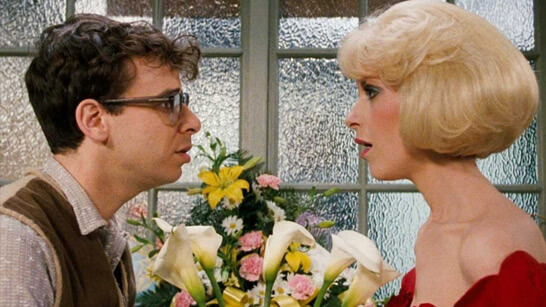 Delightfully entertaining and comical as Little Shop of Horrors may be, the story follows the structure of a tragedy, complete with a tragic hero: Seymour Krelborn (Rick Moranis, in his finest role) is a kind and klutzy clerk at a struggling flower shop who finds a “strange and interesting” plant after an unexpected solar eclipse. Unlike his coworker crush, the sweet but damaged Audrey (Ellen Greene), Seymour suffers from a low self-image. He sulks in the basement apartment owned by his boss, Mr. Mushnik (Vincent Gardenia), while Audrey submits herself to abuses, both verbal and physical, from her sadist boyfriend, Orin Scrivello, D.D.S. (Steve Martin). Both hope to escape their current situation and end up in each other’s arms. Then, Mushnik’s struggling shop is revived when Seymour places his new acquisition, Audrey II, in the window. But behind closed doors, he learns the only way to make his plant grow, thus continuing Mushnik’s financial success and earning his ticket out of Skid Row, is to feed Audrey II blood. Drip-fed from Seymour’s pricked fingers, the plant grows; it also begins to talk, a secret Seymour keeps to himself. Fame and fortune are within his grasp if he can keep Audrey II thriving. For that, Seymour agrees to a Faustian deal with his carnivorous plant—murder Audrey’s boyfriend and feed the hacked-up bits to Audrey II, and the flora from outer space will make Seymour’s dreams a reality. Fortunately, Seymour never commits murder, not directly; however, he’s hardly innocent when he and Audrey run away after they electrocute his plant and save the world from destruction. Perhaps that’s why the final shot of a budding Audrey II growing in the couple’s new garden in Suburbia, USA, seems fitting somehow.
Delightfully entertaining and comical as Little Shop of Horrors may be, the story follows the structure of a tragedy, complete with a tragic hero: Seymour Krelborn (Rick Moranis, in his finest role) is a kind and klutzy clerk at a struggling flower shop who finds a “strange and interesting” plant after an unexpected solar eclipse. Unlike his coworker crush, the sweet but damaged Audrey (Ellen Greene), Seymour suffers from a low self-image. He sulks in the basement apartment owned by his boss, Mr. Mushnik (Vincent Gardenia), while Audrey submits herself to abuses, both verbal and physical, from her sadist boyfriend, Orin Scrivello, D.D.S. (Steve Martin). Both hope to escape their current situation and end up in each other’s arms. Then, Mushnik’s struggling shop is revived when Seymour places his new acquisition, Audrey II, in the window. But behind closed doors, he learns the only way to make his plant grow, thus continuing Mushnik’s financial success and earning his ticket out of Skid Row, is to feed Audrey II blood. Drip-fed from Seymour’s pricked fingers, the plant grows; it also begins to talk, a secret Seymour keeps to himself. Fame and fortune are within his grasp if he can keep Audrey II thriving. For that, Seymour agrees to a Faustian deal with his carnivorous plant—murder Audrey’s boyfriend and feed the hacked-up bits to Audrey II, and the flora from outer space will make Seymour’s dreams a reality. Fortunately, Seymour never commits murder, not directly; however, he’s hardly innocent when he and Audrey run away after they electrocute his plant and save the world from destruction. Perhaps that’s why the final shot of a budding Audrey II growing in the couple’s new garden in Suburbia, USA, seems fitting somehow.
The production was shot on Pinewood Studios’ famous “007” stage in London, one of the largest in the world at the time. Despite the sheer size of the sets and the freedom cinematographer Robert Paynter had to move around them, Little Shop of Horrors nonetheless feels intimate, its shots tighter than that of a standard Hollywood musical. On the streets of Skid Row, there’s a staginess to everything, a quality reminiscent of West Side Story (1961) or other productions of its kind. Oz avoids grandiose camerawork or lofty visuals for their own sake, preferring instead to tell “a simple story,” he said in an interview, about “a boy, a girl and a man-eating plant.” The eye-level camera never feels more than a few steps away from a puddle of filthy street water, a dilapidated storefront, or one of the countless grotesque faces that Oz uses to set the scene. He also resists superfluous dance numbers or expressivity outside of the story. Characters burst into song, to be sure, but Little Shop of Horrors features almost no dancing outside of the Greek chorus—who both do and do not exist within the reality of the film. Oz reasoned, “If we played it too camp, the audience wouldn’t care about the characters. If we were too straight, we’d veer towards melodrama.” It’s a delicate balance the film achieves, situated somewhere between reality and fantasy.
The cast features several alumni from Saturday Night Live and Second City Television, among them Moranis, Martin, Murray, Candy, Christopher Guest, and James Belushi—faces that ensured the film’s bankability. Greene was the only member of the original Off-Broadway production to reprise her role, though the studio wanted names like Cindy Lauper and Barbara Streisand instead. The most challenging role to cast was Audrey II. Levi Stubbs from The Four Tops supplied the voice, while special FX wizard Lyle Conway, a Muppet designer and animatronics specialist from Jim Henson’s Creature Shop, conceived the plant’s iconic appearance with the help of Brian Henson. To capture the various stages of Audrey II’s growth, from a mere bud to a towering monster, six different versions were constructed, requiring nightly touch-ups to ensure its colors didn’t fade during the shoot. Conway had dozens of assistants below the floor of Mushnik’s shop or hiding just off-screen to operate the various wires and devices that made Audrey II come to life, while in-camera FX shots made his growing scenes look believable. Most convincing are Audrey II’s mouth and lip movements that, along with the expressive gestures of its head and neck, create an animated and lifelike performance that draws the viewer to the character more than the effect. In an era where digital effects have replaced physical solutions, one would be hard-pressed to find a CGI character that feels as tangible and real as Audrey II.
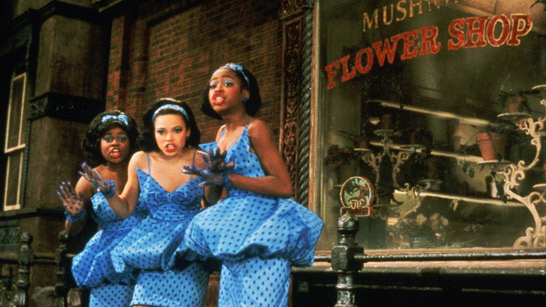 The Menken and Ashman musical updated several aspects of the 1960 film, and the 1986 film carried these alterations further. The new story is defined by its poverty, taking place in an unnamed city’s Downtown neighborhood called Skid Row, where “your life’s a joke,” and the poor urban milieu is unmistakable. Unlike the original film, Audrey II is a fully defined character with a personality—not only Mephistophelian in his promises to give Seymour whatever he desires in exchange for freshly chopped human flesh but also racially coded as African American. Audrey II speaks in familiar idiomatic expressions with the voice of Stubbs, whose music defined the Motown sound of the 1960s. That same sound inspires Audrey II, whose coded blackness has been seen as an extension of his alien otherness in an otherwise white neighborhood. When the production received criticisms for Audrey II’s lips as characteristic of caricatured imagery, Oz defensively told the Washington Post, “We weren’t trying to make it look black, we were trying to make it look like a plant, but we had to have lips… It certainly wasn’t intended and if people see it that way, I’m sorry.” Perhaps more obvious in the film’s text is the similarity between Audrey II’s mouth and Moranis’ lips, as though the plant was an expression of Seymour’s suppressed desire to rid himself of the people who have prevented him from living his dream life with Audrey. It’s telling that only Scrivello, Audrey’s abusive boyfriend, and Mushnik, Seymour’s boss who adopted him from an orphanage to carry out menial tasks in the shop, are the characters fed to Audrey II.
The Menken and Ashman musical updated several aspects of the 1960 film, and the 1986 film carried these alterations further. The new story is defined by its poverty, taking place in an unnamed city’s Downtown neighborhood called Skid Row, where “your life’s a joke,” and the poor urban milieu is unmistakable. Unlike the original film, Audrey II is a fully defined character with a personality—not only Mephistophelian in his promises to give Seymour whatever he desires in exchange for freshly chopped human flesh but also racially coded as African American. Audrey II speaks in familiar idiomatic expressions with the voice of Stubbs, whose music defined the Motown sound of the 1960s. That same sound inspires Audrey II, whose coded blackness has been seen as an extension of his alien otherness in an otherwise white neighborhood. When the production received criticisms for Audrey II’s lips as characteristic of caricatured imagery, Oz defensively told the Washington Post, “We weren’t trying to make it look black, we were trying to make it look like a plant, but we had to have lips… It certainly wasn’t intended and if people see it that way, I’m sorry.” Perhaps more obvious in the film’s text is the similarity between Audrey II’s mouth and Moranis’ lips, as though the plant was an expression of Seymour’s suppressed desire to rid himself of the people who have prevented him from living his dream life with Audrey. It’s telling that only Scrivello, Audrey’s abusive boyfriend, and Mushnik, Seymour’s boss who adopted him from an orphanage to carry out menial tasks in the shop, are the characters fed to Audrey II.
Nevertheless, several commentators persist with their observations that Audrey II could be interpreted as a racist symbol of a Black, urban threat against the white fantasy of a suburban paradise. Music scholar Marc Jensen described the film as a “monster metaphor” that is “grounded in white anxiety about racial integration” of the 1960s. Seymour and Audrey hope to escape Skid Row, a place populated by winos and street urchins—a place where monsters like Audrey II can flourish, corrupting white people with its alien blackness. In the “Somewhere That’s Green” sequence, a brilliant number that finds Audrey dreaming of a life worthy of Better Homes & Gardens magazine, Jensen argues that she hopes to escape the influence of blackness to a clean, decidedly white neighborhood of Tupperware parties and plastic on the furniture. In this line of argument, Audrey II then uses so-called urban language (“Tough Titty” or “Cut out the crap and bring on the meat!”) and performs in musical styles associated with Black culture. Meanwhile, Scrivello has been seen as an equivalent to Elvis, someone who adopts a tough exterior and appropriates African American rock-and-roll into his own mainstream sound—even though underneath his black leather jacket, there’s a white dentist’s smock. As readable as Little Shop of Horrors becomes on these terms, the interpretation does not adequately explain why three women of color, the “Skid Row Supremes”—whose names Chiffon, Crystal, and Ronette call to mind 1960s girl groups—remain the omniscient storytellers in a tale seemingly about integration anxiety. Still, as Jensen notes, once the viewer considers the film on these terms, it’s difficult not to see the racial coding throughout the film, even if it resides entirely in the subtext.
Elsewhere, Ashman and Menken have written such a lively songbook based on a pastiche of musical styles, ranging from the late 1950s to more contemporary sounds, that Little Shop of Horrors involves the viewer in its layers, always with a winking eye toward its presentation of the past through macabre comedic flourishes. It establishes links between eras with its 1960s setting and space-aged B-movie touches, just as it evokes nostalgia in its musical styles—from do-wop numbers (“Da-Doo”) to heart-wrenching ballads (“Suddenly, Seymour”) to songs worthy of a contemporary rock opera (the Oscar-nominated “Mean Green Mother from Outer Space”). Even as it triggers nostalgia, it remarks on the past with its morbid streak. The story has become a cult piece partly because it transgresses moral standards, turning its debauched and gory details into movie musical charm. Scrivello’s abusive treatment of Audrey involves handcuffs and black eyes, as his penchant for sadism defines him in the darkly funny song “Dentist!”—about his childhood fascination with hurting animals that developed into a “natural tendency” for dentistry. Later, in the song “Feed Me,” Seymour dithers at the idea of killing Scrivello for his treatment of Audrey, but it takes only a moment for his hesitation to turn into murderous certainty (“The guy sure looks like plant food to me”). Without descending into the campy flavor of The Rocky Horror Picture Show (1975), the film challenges standards of taste and representation for an amused cult viewer.
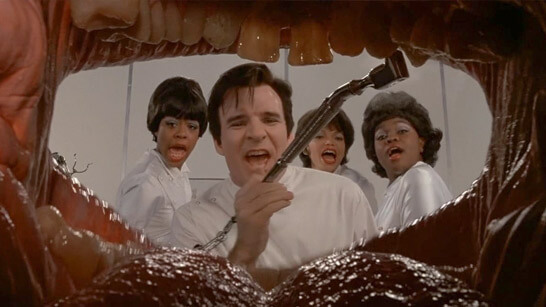 Next to perhaps The Dark Crystal (1982), Little Shop of Horrors is Oz’s most visually accomplished film, due in no small part to the Skid Row sets and special FX throughout. Paynter’s fluid camerawork, which almost always captures the performers in medium shot, shifts about the elaborate sets in sharp, intentional movements and wry angles that were carefully planned in advance—apparent in how the camera shifts among the ensemble singing “Skid Row.” Similarly, the comical timing by editor John Jympson is pitch-perfect, making every shot seem economical and intentional. More than once, but not often enough that it becomes dull, Oz places the camera at an offbeat angle, such as a god’s-eye-view or from inside the mouth of a dental patient. It’s oddities like these that keep the viewer on their toes. For instance, watch the world Oz builds around Scrivello and his motorcycle that descends from the sky in one scene, begging the question: How high was he? (Oddly, Scrivello was the second gas-sniffing psychopath to confront moviegoers in 1986, after Frank Booth, played by Dennis Hopper, in Blue Velvet.) The viewer will notice subtler details in other areas. In the opening minutes of the film, the color appears to have been drained, like the blood has been sucked out of it. But the flat colors soon transition into the shine worthy of Technicolor during the “Somewhere That’s Green” sequence—complete with intentionally artificial-looking set designs. The brightening of the palette only continues as Audrey II grows, pumping new blood into Mushnik’s shop and Seymour’s future.
Next to perhaps The Dark Crystal (1982), Little Shop of Horrors is Oz’s most visually accomplished film, due in no small part to the Skid Row sets and special FX throughout. Paynter’s fluid camerawork, which almost always captures the performers in medium shot, shifts about the elaborate sets in sharp, intentional movements and wry angles that were carefully planned in advance—apparent in how the camera shifts among the ensemble singing “Skid Row.” Similarly, the comical timing by editor John Jympson is pitch-perfect, making every shot seem economical and intentional. More than once, but not often enough that it becomes dull, Oz places the camera at an offbeat angle, such as a god’s-eye-view or from inside the mouth of a dental patient. It’s oddities like these that keep the viewer on their toes. For instance, watch the world Oz builds around Scrivello and his motorcycle that descends from the sky in one scene, begging the question: How high was he? (Oddly, Scrivello was the second gas-sniffing psychopath to confront moviegoers in 1986, after Frank Booth, played by Dennis Hopper, in Blue Velvet.) The viewer will notice subtler details in other areas. In the opening minutes of the film, the color appears to have been drained, like the blood has been sucked out of it. But the flat colors soon transition into the shine worthy of Technicolor during the “Somewhere That’s Green” sequence—complete with intentionally artificial-looking set designs. The brightening of the palette only continues as Audrey II grows, pumping new blood into Mushnik’s shop and Seymour’s future.
Oz’s film would have been all the more outlandish, in the best way possible, had the early test screenings of Little Shop of Horrors not proved so disastrous and resulted in a last-minute reshoot of the ending. The original ending mirrored the conclusion of the stage musical, where Seymour and Audrey become plant food, and Audrey II replicates, grows, and spreads chaos across the country. Oz spent millions making a laughably long procession of mass destruction and world domination, with images of crowds running from many cackling, King Kong-sized versions of Audrey II—all set to a “My Sharona”-esque guitar riff. The original ending concludes with Audrey II atop the Statue of Liberty, laughing maniacally. A thrice-punctuated “The End?!?” appears just before Audrey II bursts through the movie screen as if attacking the audience (an effect that doesn’t work for home viewing). Although quite over-the-top, the original ending is also curiously fitting, even if it betrays Oz’s desire to avoid camp. Still, test audiences hated that Seymour and Audrey never received their happily-ever-after, and the studio forced Oz to shoot the cheerier ending that appears in the theatrical and home video versions. Fortunately, it’s a heartwarming finale that fulfills Audrey’s fantasy of another life with Seymour, and it only hints at disaster with the small Audrey II bulb in their garden. Much sought-after and aggrandized over the years, the Director’s Cut version of Little Shop of Horrors was finally made available to the public in 2012, although one may still yearn for a warmer conclusion for Audrey and Seymour.
One of the more delightful aspects of Little Shop of Horrors is how well it blends tragic characters and bloody murder with a genuine, heartfelt romance—an unlikely balance facilitated by Oz’s direction, as well as Menken and Ashman’s stage musical. The endearing characters and songs overcome the story’s grimmer details, so it never feels heavy in spite of its subject matter. Never mind the comically transgressive details of Audrey’s abuse at the hand of a power-mad and perverse dentist; Seymour’s willingness to murder, however weak-willed his attempt; and the sexual current pulsing through the entire story, from Audrey’s past to Audrey II’s various come-ons. Its seedier details—such as the somehow yet-unmentioned appearance by Bill Murray as a sadomasochist who unnerves even Scrivello with his erotic joy for pain—oddly enhance the innumerable charms of these characters. The memorable songbook, too, furthers the audience’s desire to revisit the 1986 film again and again. Indeed, Little Shop of Horrors is a cabinet of curiosities, its shelves filled to the brim with influences and the potential for varied readings, whether they dismantle the film through its uses of race or embolden its structure as a Greek tragedy. But the film’s intertextuality remains secondary to its humanity, the intimacy of its musical numbers, and its million other delights that demand to be cherished.
Bibliography:
Corman, Roger, and Jim Jerome. How I Made a Hundred Movies in Hollywood and Never Lost a Dime. Da Capo Press, 1998.
Harrington, Richard. “Little Shop’s Voice of Vine and Dine; Levi Stubbs Branches Out after 29 Years in the Four Tops.” Washington Post. 2 Jan. 1987. https://www.washingtonpost.com/archive/lifestyle/1987/01/02/little-shopss-voice-of-vine-dine/bc8ac16e-126f-4d0e-b90d-23c7f17db6f1/. Accessed 6 Apr. 2020.
Jensen, Marc. “‘Feed Me!’: Power Struggles and the Portrayal of Race in ‘Little Shop of Horrors.’” Cinema Journal, vol. 48, no. 1, 2008, pp. 51–67. JSTOR, www.jstor.org/stable/20484430. Accessed 5 Apr. 2020.
Little Shop of Horrors. Dir. Frank Oz. Liner notes. Warner Bros., 2012. Blu-ray.
Vaughn, Stephen. Freedom and Entertainment: Rating the Movies in an Age of New Media. Cambridge University Press, 2006.
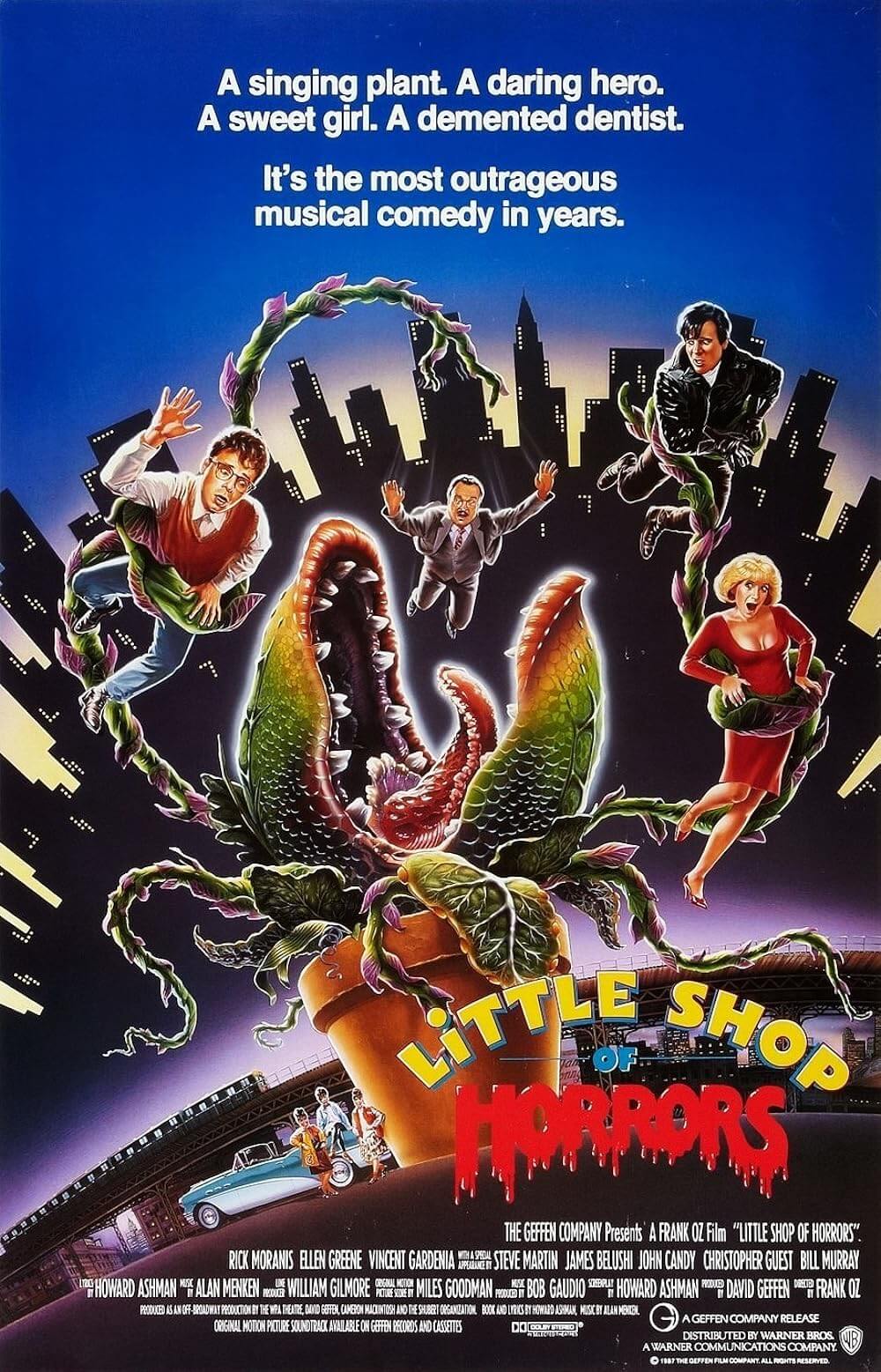
Unlock More from Deep Focus Review
To keep Deep Focus Review independent, I rely on the generous support of readers like you. By joining our Patreon community or making a one-time donation, you’ll help cover site maintenance and research materials so I can focus on creating more movie reviews and critical analysis. Patrons receive early access to reviews and essays, plus a closer connection to a community of fellow film lovers. If you value my work, please consider supporting DFR on Patreon or show your support in other ways.
Thank you for your readership!
Brian Eggert | Critic, Founder
Deep Focus Review


